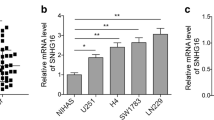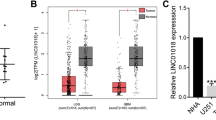Abstract
Background
Glioma has the chief type of primary brain tumors worldwide. The glioma may be controlled by regulators including some lncRNAs, miRNAs, and proteins.
Objective
Our study aims to discover the underlying mechanism for lncPCAT19/miR-142-5p/MELK axis in glioma progression.
Methods
The clinical samples were from patients with gliomas in our Hospital. Hematoxylin–eosin staining (H&E) was applied to determine the clinical pathological changes. Real time PCR was performed to measure the levels of lncPCAT19, miR-142-5p, MELK, and expression of other genes. Western blot was conducted to detect the protein level of MELK. RIP assay was performed to analyze the interaction between lncPCAT19 and miR-142-5p, and dual-luciferase reporter assay was used to determine the binding site between lncPCAT19 and miR-142-5p. CCK-8, colony formation assay, flow cytometry, and trans-well assay were carried out to confirm cell proliferation, colony formation, apoptosis, and invasion, respectively.
Results
LncPCAT19 was increased in cancer tissues. Then, lncPCAT19 could interact with and down-regulate miR-142-5p. Knockdown of lncPCAT19 distinctly inhibited tumor growth in vivo. Interfering lncPCAT19/overexpression of miR-142-5p decreased glioma cell proliferation, colony formation and invasion, and promoted cell apoptosis by down-regulating expression of Cyclin B1, CDK2, N-cadherin, Bcl-2, and by up-regulating expression of Bax and E-cadherin. Moreover, overexpression of lncPCAT19 overturned tumor-suppressing role of miR-142-5p in cells. Additionally, lncPCAT19 and miR-142-5p synergistically regulated expression of MELK. In conclusion, lncPCAT19 enhanced glioma development via increasing MELK by performing as a sponge of miR-142-5p.
Conclusions
LncPCAT19 promotes glioma progression by sponging miR-142-5p to upregulate MELK levels. Thus, lncPCAT19/miR-142-5p/MELK signaling would be a potential target for glioma treatment.





Similar content being viewed by others
References
Bartonicek N, Maag JL, Dinger ME (2016) Long noncoding RNAs in cancer: mechanisms of action and technological advancements. Mol Cancer 15:43
Cao S, Wang Y, Li J, Lv M, Niu H, Tian Y (2016) Tumor-suppressive function of long noncoding RNA MALAT1 in glioma cells by suppressing miR-155 expression and activating FBXW7 function. Am J Cancer Res 6:2561–2574
Cheng Z, Li Z, Ma K, Li X, Tian N, Duan J, Xiao X, Wang Y (2017) Long non-coding RNA XIST promotes glioma tumorigenicity and angiogenesis by acting as a molecular sponge of miR-429. J Cancer 8:4106–4116
Cheng D, Li J, Zhang L, Hu L (2019) miR-142-5p suppresses proliferation and promotes apoptosis of human osteosarcoma cell line, HOS, by targeting PLA2G16 through the ERK1/2 signaling pathway. Oncol Lett 17:1363–1371
Ganguly R, Hong CS, Smith LG, Kornblum HI, Nakano I (2014) Maternal embryonic leucine zipper kinase: key kinase for stem cell phenotype in glioma and other cancers. Mol Cancer Ther 13:1393–1398
Ganguly R, Mohyeldin A, Thiel J, Kornblum HI, Beullens M, Nakano I (2015) MELK-a conserved kinase: functions, signaling, cancer, and controversy. Clin Transl Med 4:11
Hua JT, Ahmed M, Guo H, Zhang Y, Chen S, Soares F, Lu J, Zhou S, Wang M, Li H et al (2018) Risk SNP-mediated promoter-enhancer switching drives prostate cancer through lncRNA PCAT19. Cell 174(564–575):e518
Jia Y, Duan Y, Liu T, Wang X, Lv W, Wang M, Wang J, Liu L (2019) LncRNA TTN-AS1 promotes migration, invasion, and epithelial mesenchymal transition of lung adenocarcinoma via sponging miR-142-5p to regulate CDK5. Cell Death Dis 10:573
Jiang T, Tang GF, Lin Y, Peng XX, Zhang X, Zhai XW, Peng X, Yang JQ, Huang HE, Wu NF et al (2011) Prevalence estimates for primary brain tumors in China: a multi-center cross-sectional study. Chin Med J-Peking 124:2578–2583
Joshi K, Banasavadi-Siddegowda Y, Mo X, Kim SH, Mao P, Kig C, Nardini D, Sobol RW, Chow LM, Kornblum HI et al (2013) MELK-dependent FOXM1 phosphorylation is essential for proliferation of glioma stem cells. Stem Cells 31:1051–1063
Kallen AN, Zhou XB, Xu J, Qiao C, Ma J, Yan L, Lu L, Liu C, Yi JS, Zhang H et al (2013) The imprinted H19 lncRNA antagonizes let-7 microRNAs. Mol Cell 52:101–112
Ke J, Yao YL, Zheng J, Wang P, Liu YH, Ma J, Li Z, Liu XB, Li ZQ, Wang ZH et al (2015) Knockdown of long non-coding RNA HOTAIR inhibits malignant biological behaviors of human glioma cells via modulation of miR-326. Oncotarget 6:21934–21949
Kig C, Beullens M, Beke L, Van Eynde A, Linders JT, Brehmer D, Bollen M (2017) Maternal embryonic leucine zipper kinase (MELK) reduces replication stress in glioblastoma cells. J Biol Chem 292:12786
Li Q, Dong C, Cui J, Wang Y, Hong X (2018) Over-expressed lncRNA HOTAIRM1 promotes tumor growth and invasion through up-regulating HOXA1 and sequestering G9a/EZH2/Dnmts away from the HOXA1 gene in glioblastoma multiforme. J Exp Clin Cancer Res 37:265
Meyer MA (2008) Malignant gliomas in adults. New Engl J Med 359:1850–1850
Ostrom QT, Gittleman H, Xu J, Kromer C, Wolinsky Y, Kruchko C, Barnholtz-Sloan JS (2016) CBTRUS statistical report: primary brain and other central nervous system tumors diagnosed in the United States in 2009–2013. Neuro-Oncology 18:v1–v75
Porter KR, McCarthy BJ, Freels S, Kim Y, Davis FG (2010) Prevalence estimates for primary brain tumors in the United States by age, gender, behavior, and histology. Neuro-Oncology 12:520–527
Su R, Cao S, Ma J, Liu Y, Liu X, Zheng J, Chen J, Liu L, Cai H, Li Z et al (2017) Knockdown of SOX2OT inhibits the malignant biological behaviors of glioblastoma stem cells via up-regulating the expression of miR-194-5p and miR-122. Mol Cancer 16:171
Vehlow A, Cordes N (2013) Invasion as target for therapy of glioblastoma multiforme. Bba-Rev Cancer 1836:236–244
Wu W, Yu T, Wu Y, Tian W, Zhang J, Wang Y (2019) The miR155HG/miR-185/ANXA2 loop contributes to glioblastoma growth and progression. J Exp Clin Cancer Res 38:133
Xu S, Guo J, Zhang W (2019) lncRNA PCAT19 promotes the proliferation of laryngocarcinoma cells via modulation of the miR-182/PDK4 axis. J Cell Biochem 120:12810–12821
Yan J, Yang B, Lin S, Xing R, Lu Y (2019) Downregulation of miR-142-5p promotes tumor metastasis through directly regulating CYR61 expression in gastric cancer. Gastric Cancer 22:302–313
Ye J, Zhu J, Chen H, Qian J, Zhang L, Wan Z, Chen F, Sun S, Li W, Luo C (2019) A novel lncRNA-LINC01116 regulates tumorigenesis of glioma by targeting VEGFA. Int J Cancer 146(1):248–261
Zhang M, Zhao K, Xu X, Yang Y, Yan S, Wei P, Liu H, Xu J, Xiao F, Zhou H et al (2018a) A peptide encoded by circular form of LINC-PINT suppresses oncogenic transcriptional elongation in glioblastoma. Nat Commun 9:4475
Zhang R, Jin H, Lou F (2018b) The long non-coding RNA TP73-AS1 interacted with miR-142 to modulate brain glioma growth through HMGB1/RAGE pathway. J Cell Biochem 119:3007–3016
Zhou K, Zhang C, Yao H, Zhang X, Zhou Y, Che Y, Huang Y (2018) Knockdown of long non-coding RNA NEAT1 inhibits glioma cell migration and invasion via modulation of SOX2 targeted by miR-132. Mol Cancer 17:105
Acknowledgements
We thank our team for technical cooperation.
Funding
This study received no financial supporting from government subjects.
Author information
Authors and Affiliations
Contributions
Jiao Hu designed the project. Yu-hua Xie and Jiao Hu performed the animal experiments, and Yu-hua Xie also cultured the cell lines and conducted the cell experiments. Yu-hua Xie analyzed the experimental data. Jiao Hu wrote the manuscript, and he offered discussion and suggestions. Jiao Hu provided the financial support.
Corresponding author
Ethics declarations
Conflict of interest
Yu-hua Xie and Jiao Hu declare that they have no conflict of interest.
Ethical approval
All applicable international, national, and/or institutional guidelines for the care and use of animals were followed. All procedures performed in our studies involving human participants were in accordance with the ethical standards of the institutional and/or national research committee and with the 1964 Helsinki declaration and its later amendments or comparable ethical standards.
Informed consent
Informed consent was obtained from all included participants.
Additional information
Publisher's Note
Springer Nature remains neutral with regard to jurisdictional claims in published maps and institutional affiliations.
Electronic supplementary material
Below is the link to the electronic supplementary material.
Rights and permissions
About this article
Cite this article
Xie, Yh., Hu, J. Suppression of long non-coding RNA PCAT19 inhibits glioma cell proliferation and invasion, and increases cell apoptosis through regulation of MELK targeted by miR-142-5p. Genes Genom 42, 1299–1310 (2020). https://doi.org/10.1007/s13258-020-01003-w
Received:
Accepted:
Published:
Issue Date:
DOI: https://doi.org/10.1007/s13258-020-01003-w




